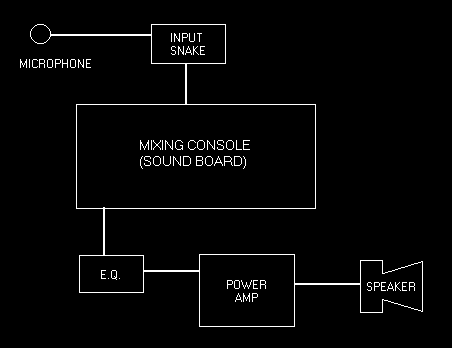 |
So let's break it down starting with the source to be amplified such as voices or electronic/acoustic instruments. Choosing the right Microphone and using it properly is one of the best ways to optimize your sound. We will cover microphones and their application in future articles but microphones basically takes acoustic energy and translates it into equivalent electrical energy sending it down the mic cable to the mixer (soundboard). The mixer takes that voltage in its particular channel and sends it though various filters (equalization). It then sends the signal across routing path points such as auxiliary sends (for stage monitors or to effects units like reverb) and master assign points (left-right, sub masters 1-2-3-4 etc.). It ends up at the channel fader or slider control (the 'volume control' for that channel to the main or sub master outputs).
There are a variety of outputs on most audio mixers so we will take the main or left/right output section as our example. From the channel fader the sound is sent (or assigned) to the main output fader[s] (which may or may not have been sent through the sub master or group section of the mixer). This fader [faders] controls the 'volume' of the mixed sound out to the next piece of equipment, which in most systems is an equalizer. Equalizers come in many different forms but all help make the system work better in the acoustic environment of the room. Remember, you can't equalize a room unless you physically change it's properties so frequencies in the sound system must be raised or lowered as they interact with the acoustics of the room in a positive or negative way. Obviously you should only touch the equalizer if you are authorized to do so and you understand how it works. From the equalizer the next piece of equipment is the power amplifier. Power amplifiers basically take the sound signal at a low voltage and convert it to a greater voltage. From the amplifier through large-gauge cable we plug in the speakers, which convert that electrical energy to acoustic energy that the speaker components are designed to reproduce.
I know that to many of you this is simple science, but a surprising number of church sound techs don't know how a basic sound system works, let alone how the sound system that they work on operates.
Some sound techs think they don't really need to know this information, but your ability to troubleshoot problems in a stressful situation (three minutes before the service is about to start) will be greatly increased if you have a basic understanding of your system. You don't need to know every design nuance but you should have a basic knowledge of the way things are routed.
If you don't know how your system is connected it is a good idea to find out if there is a diagram from the system contractor or consultant that designed the system. If your system was built in house like a portable system, you may want to have a qualified audio specialist come in and draw out a simple flow chart of your system. Also have them check that you system is connected properly. Note: do this only with the consent and cooperation of the church staff member that oversees the sound system. If your church has a sound contractor that you deal with all the time make friends with them, they want you to contact them and ask questions.
Remember that the more you know the more you can focus on the task at hand. You can also relax and have fun mixing because you're not spending the entire time figuring out 'How this stuff works'.

 Experiencing Worship, The Study
Experiencing Worship, The Study